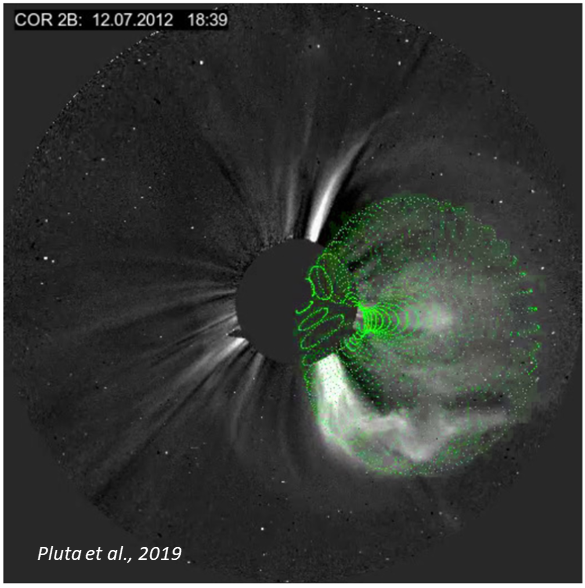The Journal of Space Weather and Space Climate (JSWSC) opens a Topical Issue "CMEs, ICMEs, SEPs: Observational, Modelling, and Forecasting Advances", to appear in 2023.
This Topical Issue stems from the European Space Weather Week 2022, primarily from Session swr02 entitled “Interplanetary Coronal Mass Ejections and Solar Energetic Particles”. However, it is not reserved to papers presented during this session, and it is open for all submissions within the scope of this Topical Issue.
Coronal mass ejections (CMEs) and their interplanetary counterparts (ICMEs) are of key interest in the field of solar-terrestrial and solar-planetary relations. They are amongst the largest and most energetic transients in the heliosphere and are the main drivers of the most intense geomagnetic storms. CMEs and ICMEs can also generate shock waves, even very low in the solar corona, producing significant fluxes of solar energetic particles (SEPs), and are important drivers of relativistic electron enhancements in the radiation belts surrounding the Earth. Solar flares associated with CME eruptions can in turn have important impacts (in terms of, e.g., UV radiation and particles) on the Earth’s atmosphere. The rise of Solar Cycle 25 and the ever-growing susceptibility of our society to solar activity are thus reinforcing the need for increasingly realistic data-driven simulations of CMEs/ICMEs and their associated shocks and particle environment using a variety of theoretical, physics-based and semi-empirical models. Additionally, the wealth of in-situ and remote heliospheric observations from novel and long-living missions (such as Parker Solar Probe, Solar Orbiter, STEREO, and SDO), and of enhanced catalogues (such as HELCATS) provide unprecedented complementary datasets for our models, enabling substantial progress in our physical understanding of CME, ICME and SEP events.
This special issue aims at highlighting recent advances in the study of CMEs/ICMEs and SEPs, and in the forecasting of their space weather impact at Earth and other locations in the heliosphere. Contributed papers may present recent developments in the observational, theoretical, and modelling investigation of CMEs/ICMEs and SEPs, including (but not limited to): ICME propagation in the heliosphere, the interaction of ICMEs with terrestrial and planetary environments, the link between CMEs and ICMEs, the generation and transport of SEPs by CME/ICME-driven shocks, and the forecasting of ICME and SEP occurrence, characteristics, and space weather impacts.
Manuscripts must be submitted via the JSWSC online submission tool. Guidelines for submission of papers are found on the JSWSC website under the tab "Instruction for Authors".
Deadline: 31 July 2023
All manuscripts will be peer reviewed according to the quality standards of international scientific journals. The type of contributions must fit the style of JSWSC. All manuscripts should contain enough new insight, present the results against a properly referenced background of existing work, and present adequate evidence that supports the conclusions.
Accepted papers are published in electronic format only, and are freely available to everyone via the JSWSC website. JSWSC offers the possibility to include electronic material, such as animations, movies, codes and data.
Topical Editor-in-Chief (T-EiC):
Camilla Scolini, University of New Hampshire, USA
Topical Editors (TE):
Luciano Rodriguez, Royal Observatory of Belgium, Belgium
Sergio Dasso, Universidad de Buenos Aires, Argentina
Nicolas Wijsen, NASA GSFC and University of Maryland College Park, USA
For questions regarding this Topical Issue, please contact the T-EiC. For questions concerning the submission process, the Editorial Office (jswsc@edpsciences.org) should be contacted.






